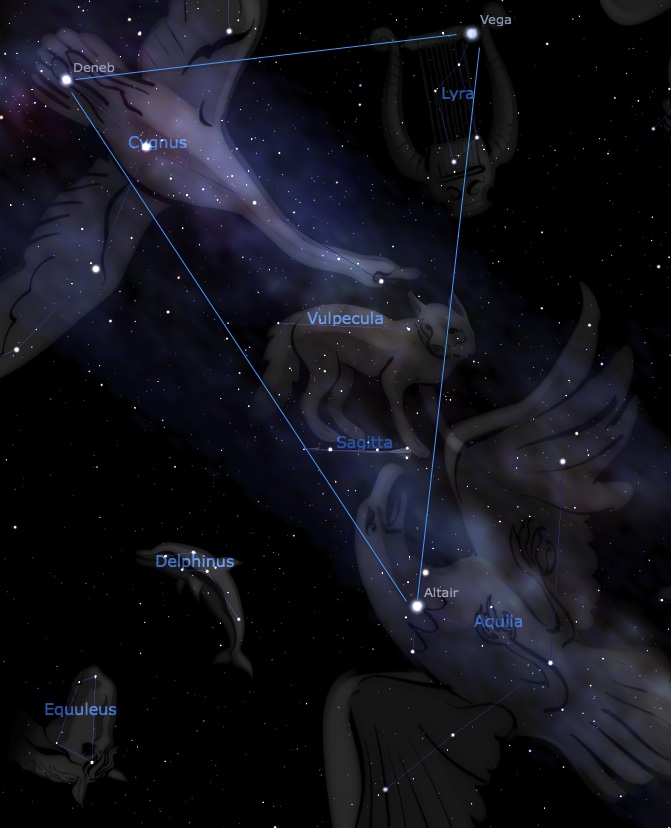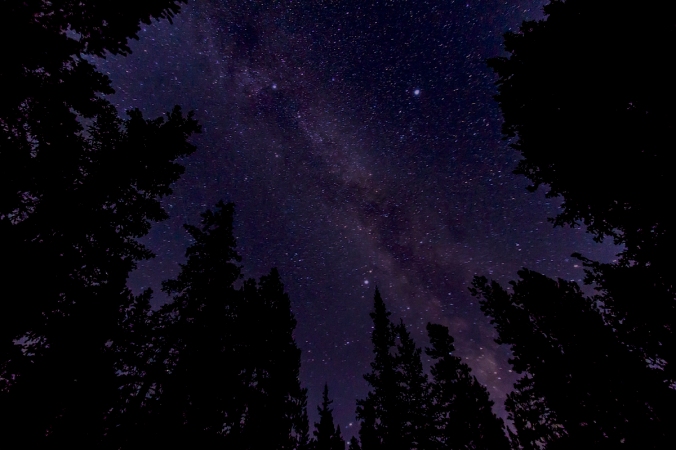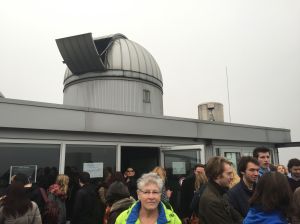Vega and Altair are well known among star gazers, as they form together with Deneb the so-called Summer Triangle. The Summer Triangle leaves inside a portion of the Milky Way, and some of the most famous astronomical targets can be found in this patch of the sky, such as the “double-double star” or the Ring Nebula (M57), both in the constellation Lyra.

Summer Triangle. Screenshot from Stellarium
Not to mention the historical importance of Vega itself in professional astronomy. Vega is the third brightest star in the sky, after Sirius and Arcturus, and its position was close to the northern celestial pole about 14000 years ago. It was also chosen as the reference star to define the brightness scale in different wavelengths. It was the first star different from the Sun to be photographed in 1872, and it has been extensively studied since the early beginnings of modern astronomy.

Photo of the Summer Triangle. By Sophie via her blog Belle Jeunesse.
But today I do not want to talk about professional astronomy. I have just learned about the Tanabata Matsuri, or Star Festival in Japanese. According to Chinese folklore, included later into the Japanese tradition, they were once two lovers called Orihime and Hikoboshi. Orihime was an immortal princess who dedicated her time to weave the finest of all garments while Hikoboshi was a mortal cow herder from a humble family. They fell deeply in love with each other in the very same instant they met. Orihime’s father found out about their love and became enraged. He condemned the lovers to be forever apart by sending each of them to a different shore to the Great Celestial River (the Milky Way). Orihime, personification of Vega, cried so much that the Universe was truly moved. On the seventh night of the seventh month thousands of magpies would be sent to build a bridge with their wings. Hikoboshi, represented by Altair, can cross then the Great Celestial River for only one night and the two lovers can be together. It is said that if it is cloudy, magpies cannot find their way to the Milky Way, and Orihime and Hikoboshi have to wait until next year, being eventual rain Orihime’s tears.

Orihime and Hikoboshi crossing the Great Celestial River over magpies’ wings. Image by Anhellica via Lilliacerise’s blog
Nowadays, people celebrate this tradition hanging their wishes, written in small pieces of paper, from bamboo.
Vega y Altair son estrellas bien conocidas entre aquellos a los que les gusta observar el cielo nocturno, ya que forman uno de los lados del llamado Triángulo de Verano. Este forma geométrica, que ayuda a identificar las constelaciones en el cielo veraniego, encierra en su interior una porción de la Vía Láctea, y algunos de los objetos que los astrónomos aficionados observan a menudo se encuentran en esta parcela del cielo, tales como la Nebulosa del Anillo (M57) o la “doble-doble”, ambos en la constelación de la Lira.
Y eso sin mencionar la importancia histórica de Vega para la astronomía profesional. Vega es la tercera estrella más brillante en nuestro cielo, después de Sirio y Arturo, y su posición la situaba como estrella polar hace unos 14000 años. Fue elegida como estrella de referencia para definir los sistemas fotométricos en distintas longitudes de onda y fue la primera estrella fotografiada después del Sol en 1872. En definitiva, se ha estudiado muy intensamente desde los primeros días de la astronomía moderna.
Pero hoy no quería hablar de astronomía profesional, sin duda habrá tiempo para eso. Es que hoy acabo de enterarme de lo que es el Tanabata Matsuri, o Fiesta de las Estrellas en japonés. Según el folclore chino, que fue adoptado más tarde por la tradición japonesa, había una vez dos amantes llamados Orihime y Hikoboshi. Orihime era una princesa inmortal, que dedicaba su tiempo a tejer las más preciosas y finas prendas mientras que Hikoboshi era un humilde pastor de vacas. Un sólo instante bastó para que se enamoraran perdidamente desde el primer momento en que se vieron. El padre que Orihime, rey del cielo, no tardó en averiguar del romance que su hija mantenía con un mortal. Enfurecido, los condenó a estar separados para siempre, mandando a cada uno a una orilla diferente del Gran Río Celestial (la Vía Láctea). Orihime, personificación de la estrella Vega, lloró con tal desolación que el Universo se emocionó. Se dispuso que el séptimo día del séptimo mes una bandada de urracas volaría hasta las estrellas para construir un puente con sus alas. Así, Hikoboshi, representado por la estrella Altair, podría cruzar el Gran Río Celestial, y los amantes podrían estar juntos sólo por una noche. Se dice que cuando está nublado, las urracas no pueden ver las estrellas y Orihime e Hikoboshi tienen que esperar al año siguiente, siendo la lluvia las lágrimas de la princesa por no poder ver a su enamorado.
En la actualidad, la fiesta contiene elementos de la tradición de los “obons” y las personas escriben sus deseos en trozos pequeños de papel y los cuelgan de cañas de bambú.




